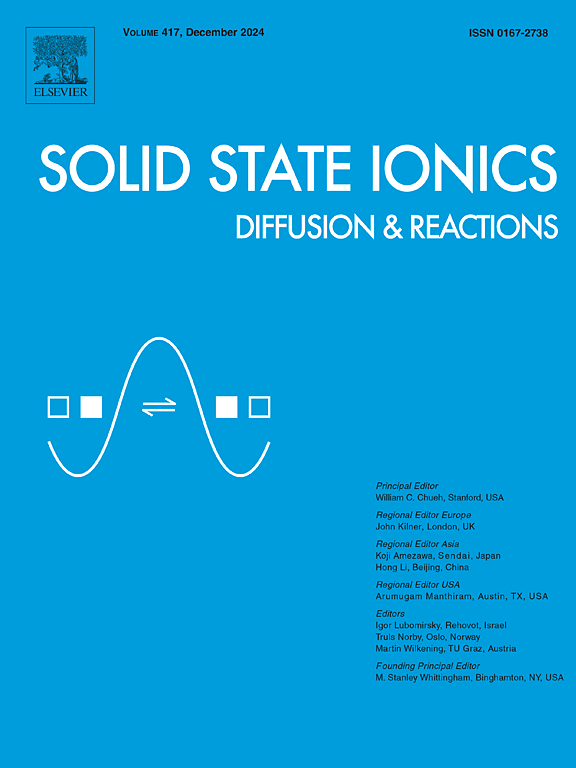Eco-selective purification to high-capacity LiFePO4: Transforming natural Iron sources via alkali-mediated green synthesis
IF 3
4区 材料科学
Q3 CHEMISTRY, PHYSICAL
引用次数: 0
Abstract
Lithium iron phosphate (LiFePO4), renowned for its thermal stability and structural safety, faces cost limitations in conventional synthesis routes. This study presents a transformative approach utilizing natural hematite concentrate through an integrated impurity engineering and structural activation strategy. Thermodynamic analysis guided a two-stage alkaline sintering process that selectively removes detrimental impurities via NaOH-mediated conversion to water-soluble Na2O·Al2O3/Na2O·SiO2 complexes, while preserving beneficial Mg dopants for enhanced ionic conductivity. Subsequent rapid quenching induces metastable Fe2O3 amorphization (68.79 wt% Fe purity) with fractured nanorod morphologies. The optimized LiFePO4 cathode exhibits exceptional electrochemical performance, delivering 155.7 mAh g−1 at 0.1C with minimal polarization, and maintains 110.7 mAh g−1 at ultrahigh 15C rates. Long-term cycling reveals 89.9 % capacity retention after 1000 cycles at 1.0C. reducing charge transfer resistance by 59 % versus conventional synthesis. This synergistic impurity removal-amorphization mechanism enables the preparation of LiFePO4 from low-grade ores, opening up a scalable route for the production of cost-competitive LiFePO4 anodes and concurrently realizing the value-added utilization of natural mineral resources. This method combines materials engineering with sustainable battery production, greatly reducing the cost of precursors compared to traditional iron sources.
高容量LiFePO4的生态选择性净化:通过碱介导的绿色合成转化天然铁源
磷酸铁锂(LiFePO4)以其热稳定性和结构安全性而闻名,但在传统的合成路线中面临成本限制。本研究提出了一种通过综合杂质工程和结构激活策略利用天然赤铁矿精矿的变革性方法。热力学分析指导了两阶段碱性烧结工艺,通过naoh介导的转化为水溶性Na2O·Al2O3/Na2O·SiO2络合物,选择性地去除有害杂质,同时保留有益的Mg掺杂剂,以增强离子电导率。随后的快速淬火导致亚稳Fe2O3非晶化(铁纯度为68.79 wt%),并形成断裂的纳米棒形貌。优化后的LiFePO4阴极表现出优异的电化学性能,在0.1C条件下以最小的极化输出155.7 mAh g - 1,在超高的15C速率下保持110.7 mAh g - 1。长期循环后,在1.0℃下循环1000次后,容量保留率为89.9%。与传统合成相比,电荷转移阻力降低59%。这种协同的杂质去除-非晶化机制使低品位矿石制备LiFePO4成为可能,为生产具有成本竞争力的LiFePO4阳极开辟了一条可扩展的路线,同时实现了天然矿产资源的增值利用。这种方法将材料工程与可持续电池生产相结合,与传统的铁源相比,大大降低了前驱体的成本。
本文章由计算机程序翻译,如有差异,请以英文原文为准。
求助全文
约1分钟内获得全文
求助全文
来源期刊

Solid State Ionics
物理-物理:凝聚态物理
CiteScore
6.10
自引率
3.10%
发文量
152
审稿时长
58 days
期刊介绍:
This interdisciplinary journal is devoted to the physics, chemistry and materials science of diffusion, mass transport, and reactivity of solids. The major part of each issue is devoted to articles on:
(i) physics and chemistry of defects in solids;
(ii) reactions in and on solids, e.g. intercalation, corrosion, oxidation, sintering;
(iii) ion transport measurements, mechanisms and theory;
(iv) solid state electrochemistry;
(v) ionically-electronically mixed conducting solids.
Related technological applications are also included, provided their characteristics are interpreted in terms of the basic solid state properties.
Review papers and relevant symposium proceedings are welcome.
 求助内容:
求助内容: 应助结果提醒方式:
应助结果提醒方式:


